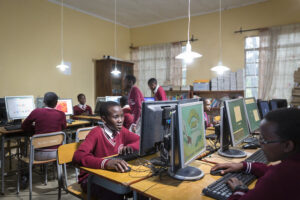
Lights to read by. Refrigeration for food and medicine. The ability to use a computer and access the internet for research. Using medical equipment such as microscopes and centrifuges. These are just a handful of the activities requiring access to a reliable energy source.
However, worldwide, tens of thousands of health facilities have no, or only unreliable electricity, and nearly one in three children attend a school without electricity.
A Focus on Sustainable Services not kWh – Designing for Sustainability with a Service-based Model
Key concepts:
- Energy access is fundamental to meaningful education and comprehensive health care.
- Off-grid solar systems can enable electrification of public facilities in many rural communities.
- Ongoing operations and maintenance are critical to the longevity of all energy systems.
- Transitioning to a solar energy service model supports affordable, sustainable, and reliable electrification.
- Remote monitoring can help advance the service model.
Our team is working together with internal and external partners across multiple sectors to help design off-grid energy access projects with a focus on health and education services as the goal of electrification. Every energy system that enables core community services needs to have a sustainable, long-term maintenance plan. Without this, systems that should last a decade or more can falter after the first few months or years, leading to economic loss and environmental waste – and most importantly, to disruption of the crucial services they were built to support. A service based model that focuses on electricity service delivery, rather than mere procurement of the solar energy systems helps ensure systems are maintained over the long term.
For off-grid solar systems, remote monitoring can now measure power supply, battery health, and energy use, and send real-time maintenance alerts to site staff, solar technicians, and ministries.
Remote monitoring can also provide the backbone for a contract model in which companies receive payment installments each month, after the monitoring system verifies that electricity has been reliably delivered onsite in accordance with established and agreed upon key performance indicators. This approach can increase the impact of donor organizations, government ministries, NGOs, finance organizations, and the private sector, by ensuring that solar equipment remains viable throughout its expected lifetime – which means that teachers and clinicians are able to focus on providing education and healthcare, with confidence that electricity will be there to support them.
A Video Introduction to Service-Based Solar Electrification:
The above video provides an overview of a 4-part video series on sustainably electrifying schools and health facilities. The series also includes:
- Sustainably Electrifying Schools and Health Facilities: The Need (Part 1 of 4)
- Sustainably Electrifying Schools and Health Facilities: Operation and Maintenance (Part 2 of 4)
- Sustainably Electrifying Schools and Health Facilities: Financing for the Long Term (Part 3 of 4)
- Sustainably Electrifying Schools and Health Facilities: Benefits of Remote Monitoring (Part 4 of 4)
Additional guidance for solar installations in public facilities:
Recent reports explore the design of private sector led models for sustainable electrification of public institutions and the need and challenges associated with the service-based approach. To support governments and programs interested in implementing a service-based model for solar installations at schools, health clinics, and other public facilities, the World Bank has published a set of guidance materials, including:
- A quality assurance framework that outlines standards for equipment, system design, and installation, and proposes key performance indicators to verify ongoing system performance using digital remote monitoring technology.
- Bid specification templates for off-grid solar systems. These build on the QA framework and provide detailed guidance for structuring technical bid specifications for service-based installations.
- An Excel-based design template which enables project teams to quickly create high-level system designs. The spreadsheet is accompanied by example designs for schools and health clinics.
Further, the World Bank has contributed to the global knowledge regarding the energy needs of the health sector, particularly in response to COVID-19, through support of the following documents:
- The Powering Health Care Catalog, produced in collaboration with SEforALL, connects stakeholders from the energy and health sectors with solar solutions providers.
- Energy Requirements for COVID-19 Testing provides a summary of the energy needs for PCR and similar temperature-sensitive tests that require a cold chain.

